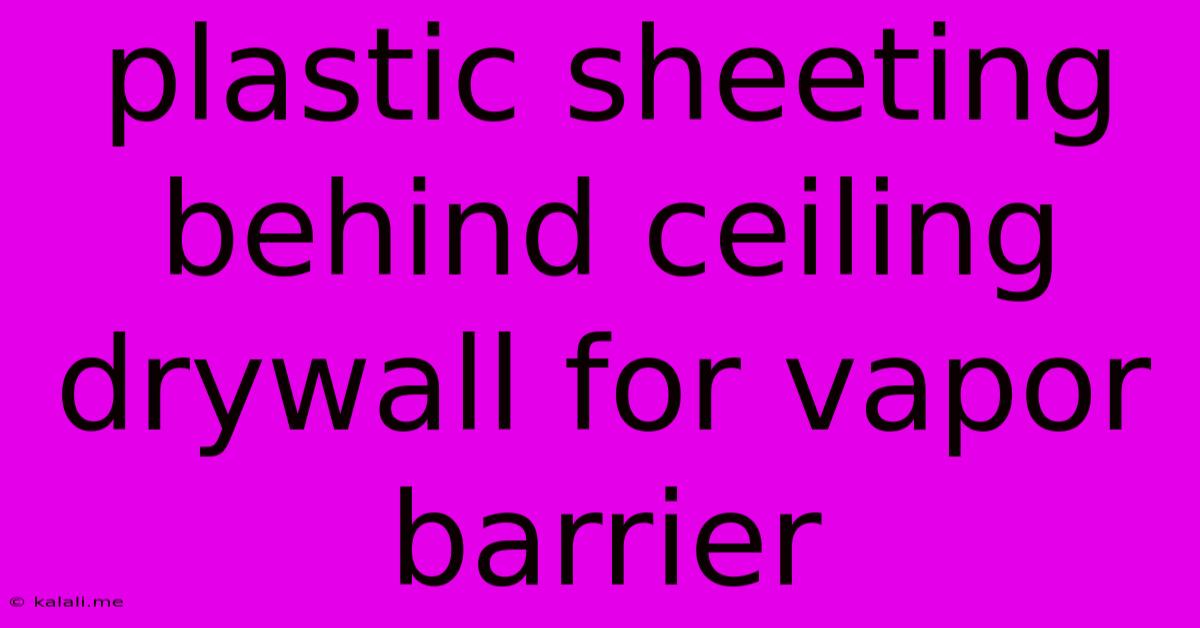Plastic Sheeting Behind Ceiling Drywall For Vapor Barrier
Kalali
Jun 07, 2025 · 3 min read

Table of Contents
Should You Use Plastic Sheeting Behind Drywall for a Vapor Barrier? A Comprehensive Guide
Meta Description: Considering using plastic sheeting behind your drywall as a vapor barrier? This guide explores the pros, cons, and best practices for using plastic sheeting as a vapor barrier in your ceiling, helping you make an informed decision.
Installing a vapor barrier is crucial for maintaining a comfortable and energy-efficient home. While plastic sheeting might seem like a cost-effective option, understanding its implications is vital before making a decision. This article delves into the nuances of using plastic sheeting behind ceiling drywall for vapor barrier purposes, weighing the advantages and disadvantages to help you make the best choice for your project.
Understanding Vapor Barriers and Their Importance
A vapor barrier is a material designed to restrict the movement of moisture (water vapor) through building materials. Water vapor, a byproduct of everyday activities like showering and cooking, can condense within wall cavities and ceilings, leading to several problems:
- Mold and mildew growth: Excessive moisture provides the perfect breeding ground for mold and mildew, impacting indoor air quality and potentially causing health issues.
- Rot and decay: Moisture can cause wood framing and other building materials to rot and decay, leading to structural damage and costly repairs.
- Reduced energy efficiency: Damp insulation loses its effectiveness, increasing your energy bills.
Choosing the right vapor barrier is essential for preventing these issues. While plastic sheeting is often considered, it's not always the ideal solution.
Plastic Sheeting as a Vapor Barrier: Pros and Cons
Pros:
- Cost-effective: Plastic sheeting is generally inexpensive compared to other vapor barrier materials.
- Easy installation: It's relatively easy to install, requiring minimal tools and expertise.
- Excellent vapor resistance: When properly sealed, plastic sheeting provides a high level of vapor resistance.
Cons:
- Susceptible to tears and punctures: Plastic sheeting can be easily damaged during installation, compromising its effectiveness. Even small holes can significantly reduce its vapor barrier capabilities.
- Difficult to repair: Repairing tears and punctures in plastic sheeting can be challenging and may not be completely effective.
- Lack of breathability: Unlike more breathable vapor barriers, plastic sheeting doesn't allow moisture to escape, potentially trapping it within the wall cavity if conditions change. This can lead to moisture build-up in colder climates, even with proper installation.
- Potential for condensation: If the plastic sheeting is not installed correctly or if there's a shift in climate conditions, condensation can form on the cooler side of the sheeting, leading to mold and mildew growth.
Better Alternatives to Plastic Sheeting
Several superior alternatives to plastic sheeting offer better performance and longevity:
- Building wraps: Designed specifically for building construction, these wraps offer superior strength and tear resistance.
- Reflective insulation: These materials combine insulation with vapor barrier properties, offering enhanced performance.
- Specialty vapor barriers: Many specialized vapor barriers are available, offering tailored solutions for different climate zones and building types.
Best Practices for Using Plastic Sheeting (If Choosing This Option)
If, despite the drawbacks, you decide to use plastic sheeting, adhere strictly to these best practices:
- Careful installation: Ensure all seams are properly overlapped and sealed with airtight tape. Use a sufficient amount of overlap to prevent tearing.
- Proper ventilation: Adequate ventilation is crucial to prevent moisture buildup. Ensure sufficient attic ventilation to remove moisture and prevent condensation.
- Climate considerations: Consider your climate zone. Plastic sheeting may be more suitable in warmer, humid climates than in colder ones.
- Professional installation: If you lack experience, consider hiring a professional to ensure proper installation and prevent potential issues.
Conclusion
While plastic sheeting might seem like an attractive option due to its low cost, it's crucial to carefully weigh the potential drawbacks. The long-term costs of dealing with moisture-related problems far outweigh the initial savings. Investing in a higher-quality, more durable vapor barrier can save you time, money, and potential health issues in the long run. Consider the climate, your budget, and the overall construction of your home before making a decision, and don’t hesitate to consult with a building professional for personalized advice.
Latest Posts
Latest Posts
-
How To Check A Leg Kick
Jun 07, 2025
-
Is It Normal For Queen Ants To Drink Water
Jun 07, 2025
-
Do You Have To Fight Undyne Before Befriending Her
Jun 07, 2025
-
How To Get Out A Broken Screw In Metal
Jun 07, 2025
-
Do You Have To Seal Quartz
Jun 07, 2025
Related Post
Thank you for visiting our website which covers about Plastic Sheeting Behind Ceiling Drywall For Vapor Barrier . We hope the information provided has been useful to you. Feel free to contact us if you have any questions or need further assistance. See you next time and don't miss to bookmark.